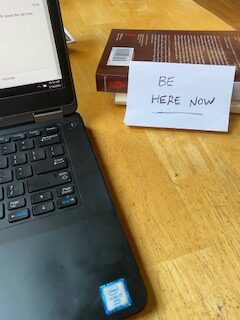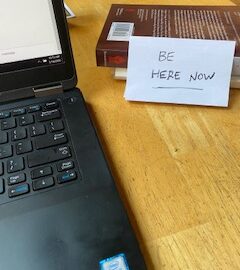Have you ever felt distracted or found it difficult to stay focused on the task at hand? Do you start a task and then find yourself starting something else halfway through? Have you told yourself you’re going to do this or that and then forget what it was you were going to do? I definitely have and this week those sort of behaviors and that mindlessness seem to be happening more often. My brain has been hijacked by the monkey mind. In Buddhism, the monkey mind describes a scattered state, a mind that jumps from one thing to the next just like a monkey jumping from tree to tree. It’s a feeling of being unsettled and ill at ease and if you’ve been there, you know it’s not a pleasant place to be.
While this has been happening I’ve also been getting messages from the universe about needing to slow down, to pause and to be present. It’s funny how that happens. The universe has a way of sending you the exact messages you need to hear. Taming our monkey mind, like any other skill, is something we can get better at through regular practice. In her book, “No Time to Lose”, author Pema Chodron says that “mindfulness tethers the mind to the present” (p.105) and that “all anxiety, fear and suffering disappear when we tame our mind” (p. 106). Practicing mindfulness is the cure for the monkey mind.
There is a lot of misconception about how to practice mindfulness is and what it actually is. Jon Kabat Zinn, professor of medicine and founder of Mindfulness Based Stress Reduction (MBSR) describes mindfulness as paying attention on purpose without judgement. That’s it….mindfulness just means paying attention and we can do it anywhere, anytime. We can practice mindful walking, mindful eating, mindful washing dishes, mindful teeth brushing and mindful breathing. We don’t just have to sit on the floor with our legs crossed for hours on end to reap the benefits. All we need to do when we find our mind wandering is to stop, take a pause and come back to the present moment. The more our mind wanders, the more opportunity we have to practice coming back and it is this practice of coming back that enables us to be more present and focused. Over time we find that we can sustain our focus for longer periods of time. It is in this present state that we can truly experience and enjoy life. The only time our lives are happening is in this moment.
To help myself practice coming back to the present moment I made a little sign as a reminder to “Be here now” and I’ve put it right next to my laptop. When my mind starts to wander, I stop, take a breath, feel my feel on the floor and come back to the present moment. If your mind has been hijacked by the monkey, try a gentle reminder like your own sign, set an alarm to remind you to pause and check in with yourself, try this mindful pause from Coach Cami, check out a meditation app like Headspace or Calm or enroll in an MBSR program online. Training our mind to stay present doesn’t have to be a big deal or be time consuming and perhaps that’s why it seems so difficult. Sometimes it’s easier to make a commitment to practice the big, hard things but it’s the little things that seem to make all the difference.




